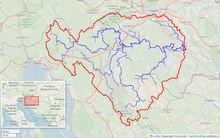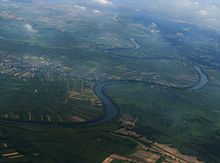Kupa
| Kupa / Kolpa | |
|---|---|
 Kolpa at Prelesje (Slovenia) | |
 Kupa River watershed (interactive map) | |
| Location | |
| Countries | |
| Physical characteristics | |
| Source | |
| • location | Razloge, Gorski kotar, Croatia |
| • coordinates | 45°29′28″N 14°41′20″E / 45.491°N 14.689°E |
| • elevation | 313 metres (1,027 ft) [1] |
| Mouth | |
• location | Sava, Sisak, Croatia |
• coordinates | 45°27′36″N 16°24′08″E / 45.46000°N 16.40222°E |
| Length | 297.4 km (185 mi) [2][3] |
| Basin size | 10,226 km2 (3,948 sq mi) [2] |
| Discharge | |
| • average | 283 m3/s (10,000 cu ft/s) |
| Basin features | |
| Progression | Sava→ Danube→ Black Sea |
The Kupa (Croatian pronunciation: [kûpa]) or Kolpa (Slovene pronunciation: [ˈkóːlpa] or [ˈkóːwpa]; from Latin: Colapis in Roman times; Hungarian: Kulpa) river, a right tributary of the Sava, forms a natural border between north-west Croatia and southeast Slovenia. It is 297 kilometres (185 miles) long,[2] with a length of 118 km (73 mi) serving as the border between Croatia and Slovenia[1] and the rest located in Croatia.[4]
Etymology
[edit]The name Colapis, recorded in antiquity, is presumed to have come from the Proto-Indo-European roots *quel- 'turn, meander' and *ap- 'water', meaning 'meandering water'. An alternative interpretation is *(s)kel-/*skul- 'shiny, bright', meaning 'clear river'.[5]

Course
[edit]
The Kupa originates in Croatia in the mountainous region of Gorski Kotar, northeast of Rijeka, in the area of Risnjak National Park. It flows a few kilometers eastwards, receives the small Čabranka River from the left, before reaching the Slovenian border.
It then continues eastwards between the White Carniola region in the north and Central Croatia in the south. The Kupa receives influx from the river Lahinja from the left in Primostek, passes Vrbovsko, and eventually detaches from the Slovenian border having passed Metlika.
It then reaches the city of Karlovac, where it receives influx from two other rivers from the right, Dobra and Korana (which in turn is joined by Mrežnica). The Kupa continues flowing to the east, where it merges with Glina from the right, it then passes through two small towns called Šišinec and Brkiševina, and then proceeds to the town of Sisak where it merges with Odra from the left and, after passing through Sisak town centre, flows into the Sava River.
Pollution
[edit]Fairly unpolluted downstream to Karlovac, the upper Kupa is a popular place for bathing in summer. The section from Stari Trg down to Fučkovci since 2006 is part of the Slovenian Krajinski park Kolpa nature reserve.
The hydrological parameters of the Kupa are regularly monitored at Radenci, Kamanje, Karlovac, Jamnička Kiselica and Farkašić.[6]
See also
[edit]References
[edit]- ^ a b Rivers, longer than 25 km, and their catchment areas, Statistical Office of the Republic of Slovenia
- ^ a b c "Sava River Basin Analysis Report" (PDF). International Sava River Basin Commission. September 2009. p. 13. Archived from the original (PDF, 9.98 MB) on 2010-07-17.
- ^ Ostroški, Ljiljana, ed. (December 2015). Statistički ljetopis Republike Hrvatske 2015 [Statistical Yearbook of the Republic of Croatia 2015] (PDF). Statistical Yearbook of the Republic of Croatia (in Croatian and English). Vol. 47. Zagreb: Croatian Bureau of Statistics. p. 49. ISSN 1333-3305. Retrieved 27 December 2015.
- ^ Surface streams and water balance of Slovenia, Ministry of the Environment and Spatial Planning
- ^ Šimunović 2013, pp. 205–206.
- ^ "Daily hydrological report". meteo.hr. Croatian Meteorological and Hydrological Service. Retrieved 2020-11-24.
Sources
[edit]- Šimunović, Petar (March 2013). "Predantički toponimi u današnjoj (i povijesnoj) Hrvatskoj" [Pre-Roman placenames in present-day (and historical) Croatia] (PDF). Folia onomastica Croatica (in Croatian) (22). Zagreb: Croatian Academy of Sciences and Arts: 147–214. Retrieved 18 January 2016.
Further reading
[edit]- Babić, Marko (1985). "Sliv rijeke Kupe traži zaštitu" [The Basin of the River Kupa Seeks Protection]. Priroda: popularni časopis hrvatskog prirodoslovnog društva. Vol. 72, no. 8. p. 242. ISSN 0351-0662.
- Kekuš, Milan (1984). "Geomorfološke osobine doline Kupe između Karlovca i Siska" (PDF). Hrvatski geografski glasnik (in Croatian). 46 (1): 21–50. Retrieved 24 November 2020.
External links
[edit]- source of Kupa pictures
- Panoramic of the source
- Awarded "EDEN - European Destinations of Excellence" non traditional tourist destination 2010
Hydrography of Croatia | ||||||
|---|---|---|---|---|---|---|
| Rivers |
| |||||
| Lakes | ||||||
| Valleys, estuaries, canyons, wetlands | ||||||
| Waterfalls | ||||||
| Canals |
| |||||
| Adriatic Sea | ||||||
Hydrography of Slovenia | ||
|---|---|---|
| Rivers |
| |
| Streams | ||
| Waterfalls | ||
| Lakes | ||
| Wetlands | ||
| Sea | ||
| River valleys |
| |
| Canyons and gorges |
| |
Text is available under the CC BY-SA 4.0 license; additional terms may apply.
Images, videos and audio are available under their respective licenses.


